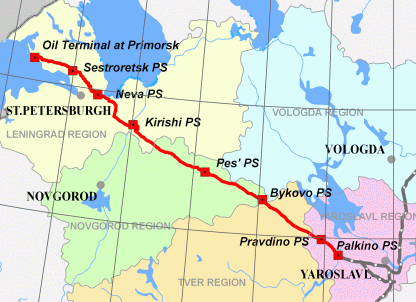Baltic Pipeline System (BPS)Baltic Pipeline System (BPS) was built to transport the crude from fields in Western Siberian, Timan-Pechora and Volga-Urals petroleum provinces to a terminal on the coast of the Gulf of Finland for export.
The system includes an existing oil pipeline, which links Haryaga and Usa, trunk pipelines from Usa to Ukhta to Yaroslavl to Kirishi, new trunk pipelines between Haryaga and Usa and between Kirishi the coast of the Gulf of Finalnd, and finally the new oil export terminal in the city of Primorsk.

1999. Environmental Centre IFPA developed the Environmental Protection section in the BPS Technical and Economical Feasibility Study (the so-called TEOC), which covered phase 1 of the project (Yaroslavl – Kirishi – Primorsk).
The facilities designed by the project are located in four contiguous Russian regions – the oblasts of Yaroslavl, Tver, Novgorod and Leningrad.
The project assets designed under BPS included:
-
new and reconstructed sections of an oil pipelines to a total length of 1,300 km;
-
three booster stations;
-
tanks farms at the booster stations (80,000 m3) and another one at the terminal (500,000 m3).
The project provides for special design solutions to maximize environmental safety. These special solutions included:
- First ever in environmental protection practice, a microtunnel with gas envelopment and with a safeguarding cover was built to go under the channel of river Neva;
- The particularly sensitive zones in the water catchment basin of the Neva and the lake of Ladoga were crossed by using special protective cover on the pipeline;
- Kirishi booster station was relocated 20 km off its originally planned site for air quality concerns.
2001. An Environmental Impact Assessment (EIA) as part of the investment feasibility study for oil pipelines in the region of Nenets Autonomous Okrug.
The pipelines were intended to bring the oil from the remote fields of Nenets Autonomous Okrug and feed it into the existing system of BPS pipelines.
The project included:
2001. Environmental Protection book as part of the BPS TEOC covering the section from Haryaga to Usa (phase 1).
The Haryaga-Usa pipeline is intended to feed the crude of the fields of Timan-Pechora oil province into the pipeline system run by AK Transneft. The link connects Haryaga booster station close to the oilfield of the same name with the inlet of Usa pump station threaded onto the Usa-Ukhta oil pipeline.
Project assets under design include:
2002. Environmental Protection book as part of the BPS TEOC for the section from Yaroslavl to Kirishi to Primorsk (phase 2).
The second phase of BPS included the construction of several loopings, the reconstruction of existing pump stations and the building of new ones to boost the throughput capacity of the then-existing oil pipeline system to reach a figure of 18 million tons of petroleum per year.
2002. Environmental Protection book as part of the BPS TEOC (phase 3).
The intention of phase 3 was to further develop Baltic Pipeline System to increase the export of petroleum to 50 million tons a year and deliver this quantity to the sea port of Primorsk.
This ambition was fulfilled by:
-
building a new pipeline, 1,020 mm in diameter, in the same technological corridor with the right-of-way of BPS phase 1, about 710 km long;
-
reconstructing and building extra facilities at the booster stations and at the oil export terminal;
-
building the loopings.
2003. Environmental Protection book as part of the BPS TEOC (phase 3).
The intention was to further develop Baltic Pipeline System to increase the export of petroleum to 62 million tons a year and deliver this quantity to the sea port of Primorsk.
This ambition was fulfilled by:
-
building loopings, 1,020 mm in diameter, in the same technological corridor with the BPS pipeline route;
-
reconstructing and building extra facilities at the booster stations (Nevskaya, Sestroretskaya, Pesj, Pravdino, Yaroslavskaya) and at the oil export terminal;
-
building an additional pipeline section from Yaroslavl dispatcher station to Koromyslovo pump station in Yaroslavl region;
-
construction of a shunt pipe to Kirishi 1.
2004. Updating the Environmental Protection book in BPS phase 3 TEOC.
The task was to update several sections in the book to reflect project extra facilities.
|